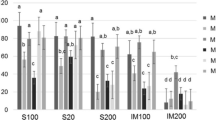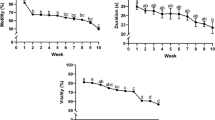Abstract
The post-thaw motility and fertility of Japanese pearl oyster sperm show large variances, even among sperm samples obtained from the same individuals. This study aimed to clarify the factors that cause such differences. Spermatozoa were diluted 50 times with diluent comprising 10 % methanol, 18 % fetal bovine serum, and 72 % seawater, and dispensed into 0.25 ml straws. A total of 59 straws were cooled, one by one, at 11 different heights from the surface of liquid nitrogen (LN) to −50 °C, and then immediately immersed in LN. After thawing the straws, the relationships between the cooling rate and the post-thaw motility and post-thaw fertility of the spermatozoa were examined. Both the post-thaw motility and the post-thaw fertility showed a sharp peak when the straws were cooled at around −20 °C/min. There was a strong correlation between post-thaw motility and fertility (P < 0.001). There was a large difference in the cooling rates and the post-thaw motilities and fertilities of the spermatozoa, even between straws cooled at the same height. These results indicate that the optimum range for the cooling rate of oyster spermatozoa is quite narrow, and the method of cooling straws at a fixed distance from the LN surface is unsuitable for the cryopreservation of Japanese pearl oyster spermatozoa.




Similar content being viewed by others
References
Wada K (1984) Breeding study of the pearl oyster, Pinctada fucata. Bull Natl Res Inst Aquac 6:79–157
Kawamoto T, Narita T, Isowa K, Aoki H, Hayashi M, Komaru A, Ohta H (2007) Effects of cryopreservation methods on post-thaw motility of spermatozoa from the Japanese pearl oyster, Pinctada fucata martensii. Cryobiology 54:19–26
Farrant J, Walter CA, Lee H, McGann LE (1977) Use of two-step cooling procedures to examine factors influencing cell survival following freezing and thawing. Cryobiology 14:273–286
Leung LKO (1991) Principles of biological cryopreservation. In: Jamieson BGM (ed) Fish evolution and systematics; evidence from spermatozoa. Cambridge University Press, Cambridge, pp 231–244
McAndrew BJ, Rana KJ, Penman DJ (1993) Conservation and preservation of genetic variation in aquatic organisms. In: Muir JF, Roberts RJ (eds) Recent advances in aquaculture IV. Blackwell, Oxford, pp 297–336
Tiersch TR, Yang H, Jenkins JA, Dong Q (2007) Sperm cryopreservation in fish and shellfish. In: Roldan ERS, Gomendio M (eds) Spermatology (Society of Reproduction and Fertility supplement 65). Nottingham University Press, Nottingham, pp 493–508
Adams SL, Smith JF, Roberts RD, Janke AR, Kaspar HF, Tervit HR, Pugh PA, Webb SC, King NG (2004) Cryopreservation of sperm of the Pacific oyster (Crassostrea gigas): development of a practical method for commercial spat production. Aquaculture 242:271–282
Ieropoli S, Masullo P, Espirito Sango DM, Sansone G (2004) Effects of extender composition, cooling rate and freezing on the fertilization viability of spermatozoa of the Pacific oyster (Crassostrea gigas). Cryobiology 49:250–257
Dong Q, Huang C, Eudeline B, Tiersch TR (2005) Systematic factor optimization for cryopreservation of shipped sperm samples of diploid Pacific oysters, Crassostrea gigas. Cryobiology 51:176–197
Acosta-Salmón H, Jerry DR, Southgate PC (2007) Effects of cryoprotectant agents and freezing protocol on motility of black-lip pearl oyster (Pinctada margaritifera L.) spermatozoa. Cryobiology 54:13–18
Ohta H, Kawamoto T, Isowa K, Aoki H, Hayashi M, Narita T, Komaru A (2007) Motility of spermatozoa obtained from testis of the Japanese pearl oyster Pinctada fucata martensii. Fish Sci 73:107–111
Kuwatani Y (1965) Studies on the breeding of the Japanese pearl oyster, Pinctada martensii (Dunker), I. Change in the maturation of the eggs obtained from the excised gonads during the spawning season. Bull Natl Pearl Res Lab 10:1228–1243
Wada SK (1961) Studies on the fertilization of Pelecypod gametes. I. Increase in maturity and accomplishment of fertilization of pearl oyster in ammonical sea water. Mem Fac Fish Kagoshima Univ 10:1–8
Ohta H, Kawamura K, Unuma T, Takegoshi T (2001) Cryopreservation of the sperm of the Japanese bitterling. J Fish Biol 58:670–681
Ohta H, Arita K, Isowa K, Ishikawa T, Aoki H (2010) Development of an artificial fertilization method for the Japanese pearl oyster Pinctada fucata martensii by using a microplate. Aquac Sci 58:517–523
Chao NH, Liao NH (2001) Cryopreservation of finfish and shellfish gametes and embryos. Aquaculture 197:161–189
Gwo JC (2000) Cryopreservation of aquatic invertebrate semen: a review. Aquac Res 31:259–271
Gwo JC (2000) Cryopreservation of some marine fishes. In: Tiersch TR, Mazik PM (eds) Cryopreservation in aquatic species. World Aquaculture Society, Baton Rouge, pp 138–160
Narita T, Kawamoto T, Isowa K, Aoki H, Hayashi M, Ohta H, Komaru A (2008) Effects of cryopreservation on sperm structure in Japanese pearl oyster, Pinctada fucata martensii. Fish Sci 74:1069–1074
Yokoi K, Kuwada T, Yamane K, Nishiguchi Y, Yamamoto S, Gouda M, Takii K, Ohta H (2009) Hormone injections enhance the tolerance of land-locked ayu spermatozoa to cryopreservation. Aquac Res 40:1893–1898
Acknowledgments
This research was supported by research grants from the Ministry of Agriculture, Forestry and Fisheries, Japan, and the Global COE Program from the Ministry of Education, Culture, Sports, Science and Technology, Japan.
Author information
Authors and Affiliations
Corresponding author
Rights and permissions
About this article
Cite this article
Arita, K., Isowa, K., Ishikawa, T. et al. Effects of cooling rate on post-thaw motility and fertility of Japanese pearl oyster Pinctada fucata martensii spermatozoa. Fish Sci 78, 625–630 (2012). https://doi.org/10.1007/s12562-012-0487-3
Received:
Accepted:
Published:
Issue Date:
DOI: https://doi.org/10.1007/s12562-012-0487-3




